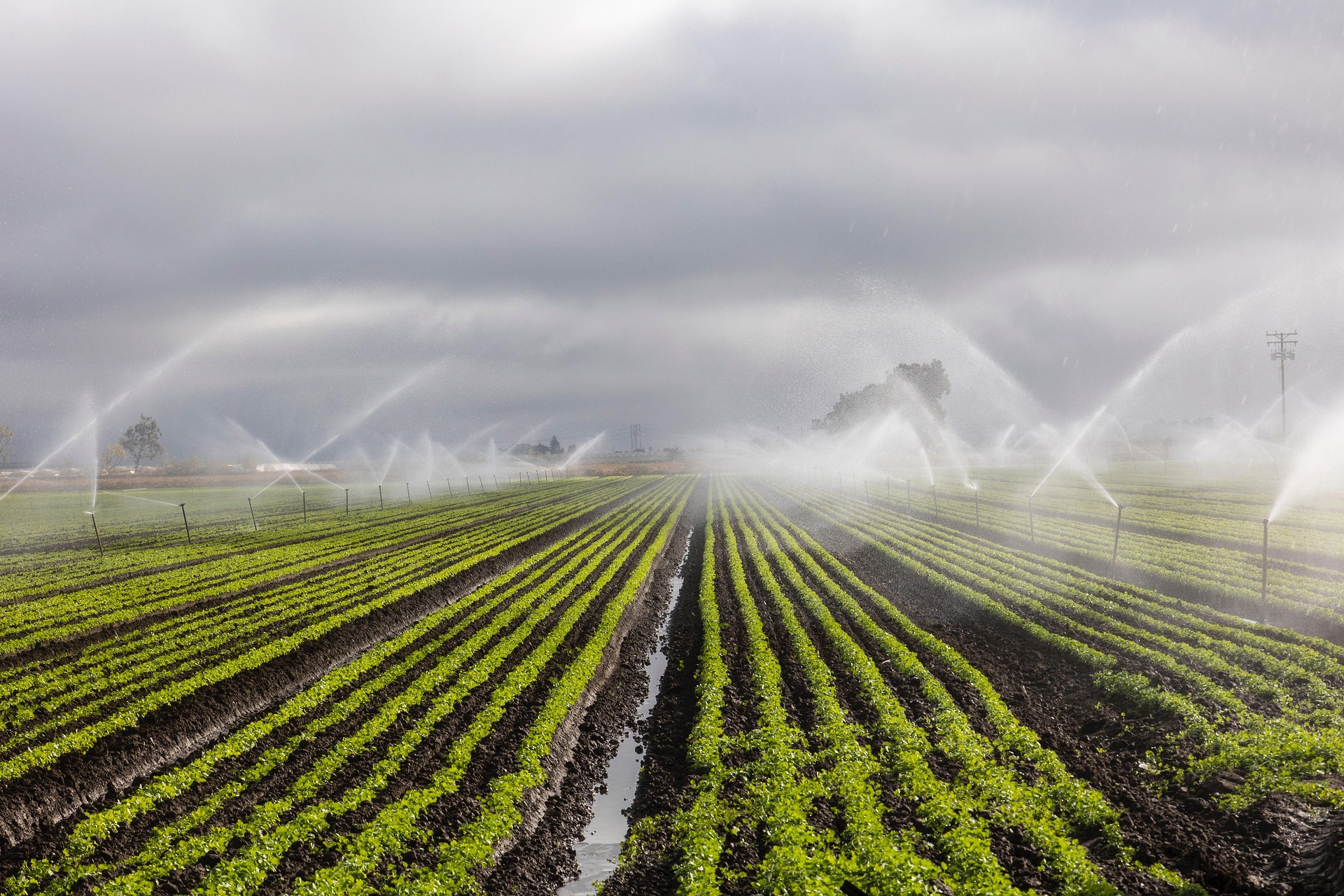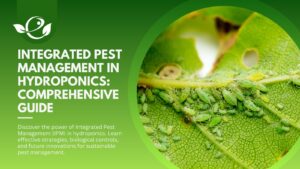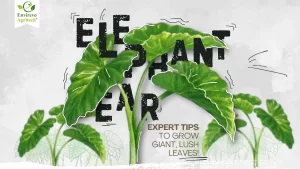Table of Contents
In an era where climate change accelerates and the global population continues to rise, the strain on our planet’s freshwater resources has reached unprecedented levels. Agriculture, the backbone of food production, is at the heart of this challenge, consuming approximately 70% of the world’s freshwater withdrawals. In some developing nations, this figure escalates to over 90%, underscoring the sector’s pivotal role in global water consumption.
As water scarcity intensifies, the imperative for efficient irrigation methods becomes more pressing. Drip irrigation emerges as a beacon of innovation in this landscape, offering a method that not only conserves water but also enhances crop yields and quality. Studies have demonstrated that this technique can increase crop yields by up to 20% and improve water use efficiency by 30%, marking a substantial advancement in sustainable agriculture. In this comprehensive exploration, we will delve into the mechanics of drip irrigation, weigh its advantages against its drawbacks, and provide insights into its practical applications. Our goal is to equip you with a nuanced understanding of whether drip irrigation aligns with your agricultural objectives and environmental conditions.
Historical Background and Evolution of Drip Irrigation
Traditional Irrigation vs. Modern Needs
Before drip irrigation became prevalent, traditional irrigation methods such as flood and sprinkler systems dominated agricultural practices. While these methods have served their purpose over centuries, they often lead to significant water wastage and uneven distribution.
Emergence and Early Adoption
Drip irrigation began as a modest innovation, with early experiments in water-scarce regions like Israel. Farmers sought a solution that would conserve water while ensuring crops received a consistent, optimal amount of hydration. This approach gradually evolved, with simple systems giving way to more sophisticated designs that incorporated filters, pressure regulators, and emitter technology.
Global Spread and Innovations
Over the decades, drip irrigation has gained worldwide acceptance, particularly in regions facing water scarcity. This method has evolved through extensive research and real-world applications, resulting in significant advancements in design and functionality. Modern systems now incorporate sophisticated techniques that allow for precise water delivery, adapting efficiently to a variety of climates and soil conditions. This evolution reflects the collective insights from both scientific studies and practical experiences in agriculture, establishing drip irrigation as a cornerstone of sustainable water management practices.
Understanding Drip Irrigation
Definition and Core Principles
At its core, drip irrigation involves delivering water slowly and directly to the root zone of plants through a network of tubes, pipes, and emitters. This method ensures that each plant receives the precise amount of water required, reducing evaporation and runoff.
Key Components of Drip Irrigation
A drip irrigation system comprises several integral components, each meticulously designed to ensure efficient water delivery directly to the plant root zones. Understanding these components is essential for designing, installing, and maintaining an effective system. Below is an in-depth exploration of the key elements:
1. Water Source
The system begins with a reliable water source, which can be either: Groundwater (Accessed via wells or boreholes) or surface Water (Obtained from rivers, lakes, or reservoirs).
The choice of water source influences the design and filtration requirements of the system.
2. Pumping Unit
A pump is often necessary to provide the appropriate pressure and flow rate for the system. The selection of the pump depends on factors such as the water source depth, the required pressure, and the system’s overall water demand.
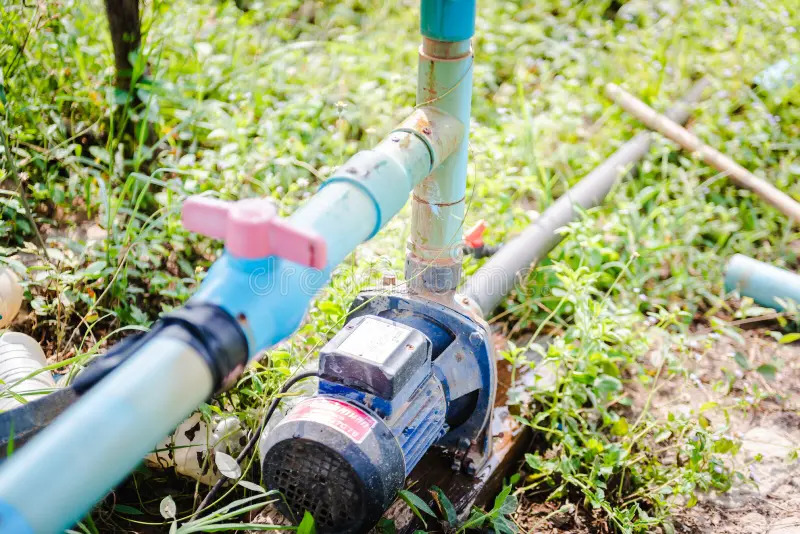
3. Filtration System
To prevent clogging of emitters, it’s crucial to filter out debris and particulates from the water. Common filtration methods include:
- Screen Filters: Utilize a mesh to trap particles.
- Sand Filters: Effective for removing organic matter and fine sediments.
- Disc Filters: Consists of a series of grooved discs that capture impurities.

4. Backflow Preventer
This device prevents the reverse flow of water, safeguarding the water source from potential contamination by fertilizers or chemicals used in the irrigation process.
5. Pressure Regulators
Drip irrigation systems operate optimally within specific pressure ranges. Pressure regulators ensure that water pressure remains within these limits, protecting system components and ensuring uniform water distribution.

6. Mainline and Sub-main Pipes
These pipes transport water from the source to various zones within the irrigation system:
- Mainline Pipes: Typically larger in diameter, they carry water from the source to the sub-main pipes.
- Sub-main Pipes: Distribute water from the mainline to the lateral lines or drip tubing.
Materials commonly used include polyethylene and PVC, chosen for their durability and resistance to environmental factors.
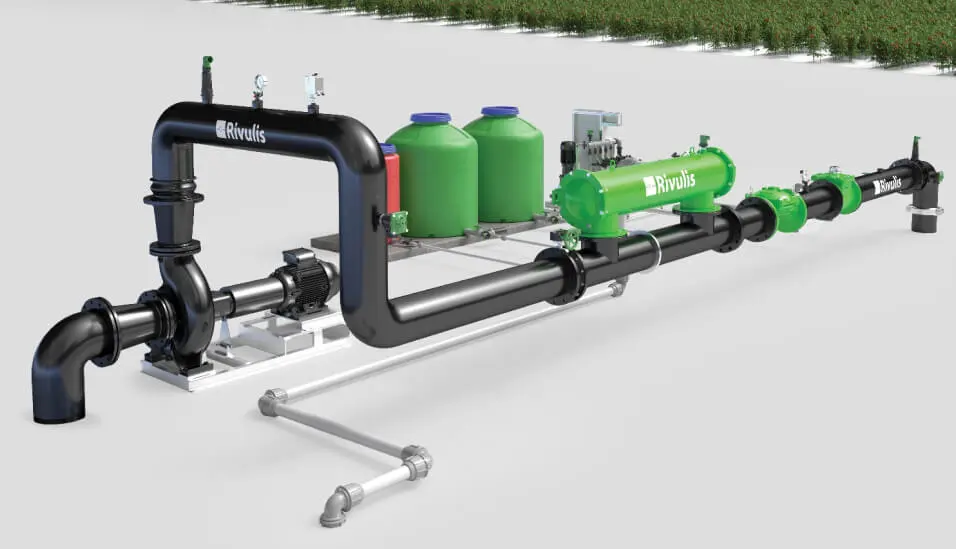
7. Valves
Valves control the flow of water within the system and can be categorized as:
- Control Valves: Manage the opening and closing of water flow to different zones.
- Flush Valves: Allow for periodic flushing of the system to remove accumulated debris.
- Air Release Valves: Prevent air locks by releasing trapped air within the pipes.
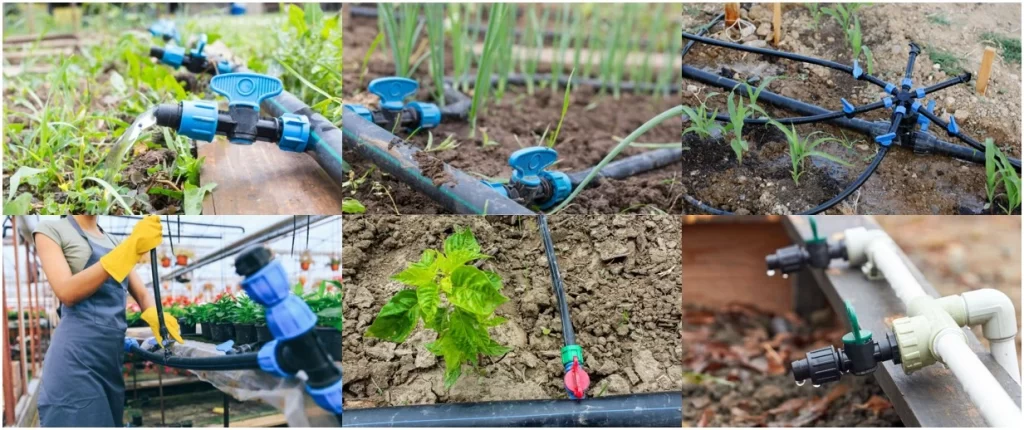
8. Drip Tubing (Laterals)
Flexible polyethylene tubes, known as laterals, deliver water from the sub-main pipes to the plants. They are UV-resistant and designed to withstand environmental stresses.
9. Emitters (Drippers)
Emitters are devices attached to the drip tubing that release water directly to the plant root zone. They come in various types:
- Pressure-Compensating Emitters: Deliver a consistent flow rate regardless of pressure variations.
- Non-Pressure-Compensating Emitters: Flow rate varies with pressure changes.
- Adjustable Emitters: Allow users to modify the flow rate as needed.
Proper emitter selection is vital for meeting the specific water requirements of different plants.
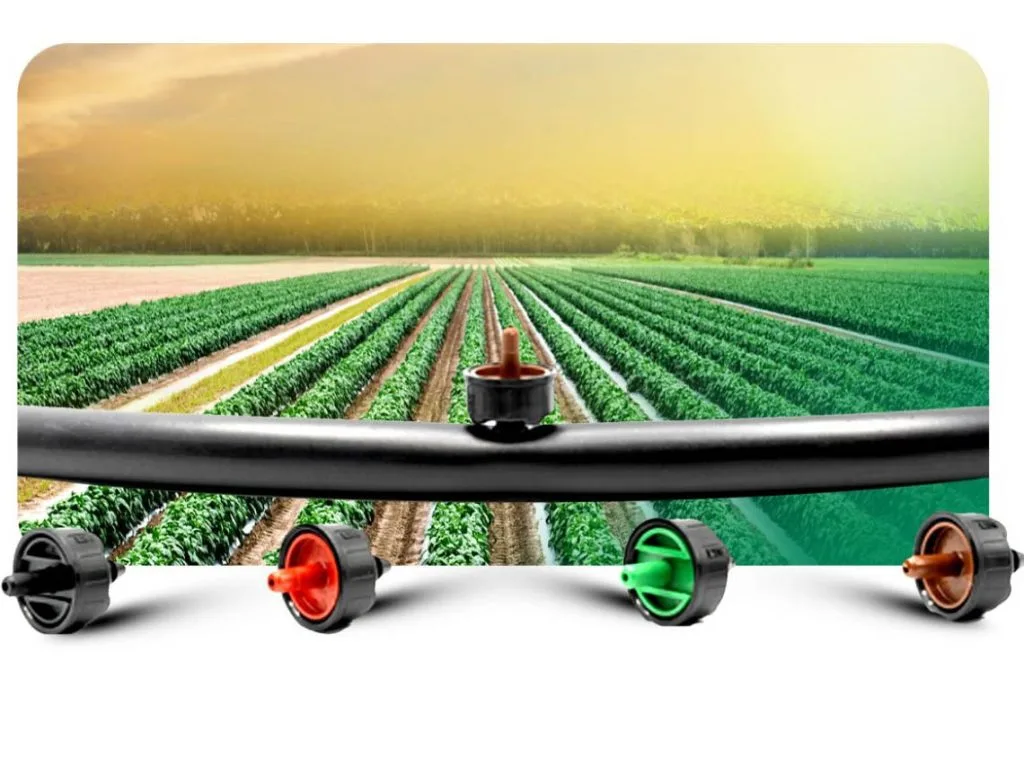
10. Fittings and Connectors
These components join various parts of the system, ensuring leak-proof connections. They include:
- Elbows: Change the direction of the tubing.
- Tees: Split the flow into multiple directions.
- Couplings: Connect two sections of tubing.
- End Caps: Seal the ends of tubing lines.
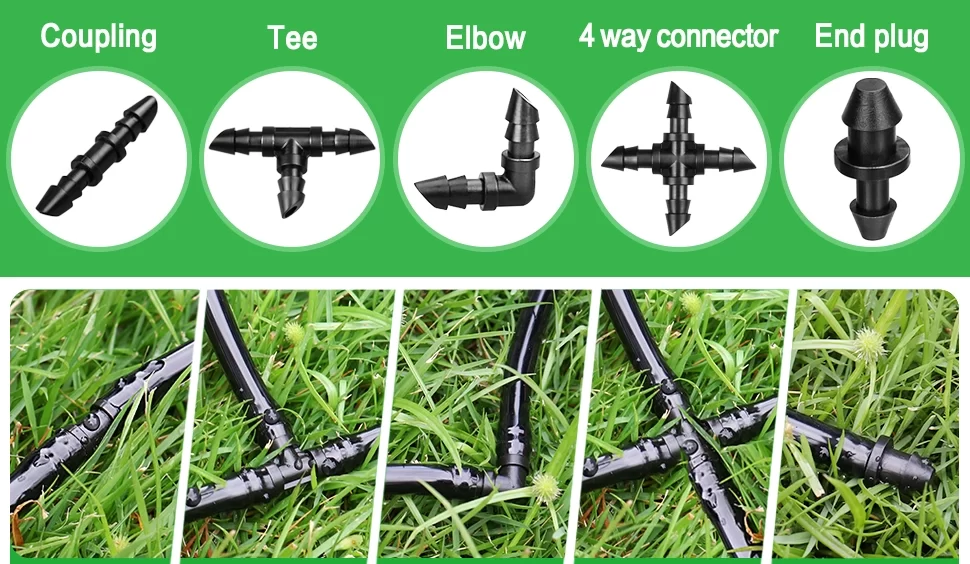
11. Pressure Gauges and Flow Meters
Monitoring devices that help in assessing the system’s performance by measuring water pressure and flow rates, enabling timely adjustments and maintenance.
12. Fertigation Equipment
Integrating fertilization with irrigation, fertigation systems allow for the application of nutrients directly through the drip system, enhancing nutrient uptake efficiency.
Types of Drip Systems
Drip irrigation systems are available in several configurations:
- Surface Systems: Laid on top of the soil, best suited for row crops and home gardens.
- Subsurface Systems: Buried below the soil surface, ideal for reducing evaporation even further and preventing weed growth.
- Smart or Automated Systems: Integrated with sensors and control units for real-time monitoring and adjustments, ensuring optimal performance.

How Drip Irrigation Works
Drip irrigation is a sophisticated water delivery system designed to optimize the distribution of water directly to plant roots. Its operation can be understood by breaking down several key elements and design considerations:
Mechanism of Action
At its core, drip irrigation operates by releasing water in a slow, steady, and controlled manner at the base of each plant. This localized application of water ensures that it infiltrates the soil gradually, reaching the root zone where it is most needed. The system utilizes small devices called emitters, which regulate the flow rate, thereby minimizing water loss due to evaporation or runoff. This approach not only conserves water but also promotes deeper root penetration and improved nutrient uptake.
Types of Emitters and Flow Control
Emitters are critical to the performance of a drip irrigation system. They are available in various designs, including pressure-compensating emitters that deliver a consistent flow rate regardless of changes in water pressure, and non-pressure-compensating emitters that may be more susceptible to pressure variations. The selection of emitters depends on several factors such as soil type, plant water requirements, and system layout. Additionally, many modern systems feature adjustable emitters, allowing for fine-tuning of water distribution based on specific crop needs or environmental conditions.
System Layouts and Design Considerations
Designing an effective drip irrigation system requires meticulous planning:
- Layout and Zoning: The area to be irrigated is divided into zones, with each zone tailored to the water requirements of the plants it supports. This zoning is critical for addressing variations in soil type, topography, and micro-climates within the irrigation area.
- Emitter Spacing: Determining the optimal spacing between emitters is essential to ensure uniform water distribution. This involves careful consideration of plant spacing and the depth of the root system.
- Water Pressure Management: Maintaining an optimal water pressure is crucial. Pressure regulators are often integrated into the system to keep the flow consistent and to prevent damage to emitters.
- Tubing and Distribution Network: The network of tubes and pipes acts as the delivery conduit, carrying water from the main supply to each emitter. The design of this network must minimize bends and pressure drops, ensuring an even distribution throughout the system.
Integration of Technological Innovations
Modern drip irrigation systems have benefited greatly from technological advancements:
- Smart Sensors and Automation: These systems can now incorporate soil moisture sensors that continuously monitor conditions and adjust the water output automatically. This not only ensures that the plants receive the right amount of water at the right time but also helps in reducing waste.
- Remote Monitoring and Control: Automation allows users to manage their systems remotely through digital interfaces, enabling real-time adjustments and performance tracking.
- Data-Driven Management: Integrating data analytics into irrigation systems helps in identifying trends and optimizing water usage over time. This approach allows for predictive maintenance and fine-tuning of the system based on historical performance data.
Water Movement and Soil Interaction
The efficacy of drip irrigation also hinges on the interaction between water and soil. As water is applied slowly:
- Infiltration Rate: The soil’s natural infiltration rate determines how quickly water percolates to the roots. Drip systems are designed to match this rate, ensuring that water is neither lost to deep percolation nor remains on the surface.
- Soil Moisture Uniformity: By applying water directly to the root zone, the system helps maintain consistent soil moisture levels, which is essential for healthy plant growth.
- Reduced Runoff: Since water is delivered in small, measured doses, the likelihood of runoff is significantly reduced, which helps preserve both soil structure and valuable water resources.
Integration with Nutrient Management
An additional advantage of drip irrigation is its compatibility with fertigation—the practice of delivering fertilizers through the irrigation system. This integration allows for:
- Targeted Nutrient Delivery: Fertilizers are applied directly to the root zone along with water, ensuring that plants receive a balanced nutrient supply.
- Efficiency and Timing: Nutrient application can be scheduled to coincide with critical growth periods, thereby maximizing uptake and reducing waste.
By understanding these detailed aspects of how drip irrigation works, it becomes clear why this method is widely regarded as one of the most efficient irrigation systems available today. Its combination of precision, efficiency, and adaptability makes it an indispensable tool in modern water management practices, capable of meeting the diverse needs of agriculture, landscaping, and beyond.
Advantages and Benefits of Drip Irrigation
Water Efficiency and Conservation
Drip irrigation is renowned for its ability to save water. By delivering water directly to the roots, it minimizes evaporation, runoff, and deep percolation losses. This precise application results in substantial water savings, particularly in arid regions or during drought conditions.
Improved Plant Health and Crop Yields
Consistent, targeted watering leads to:
- Enhanced Root Development: Promotes deeper and healthier root systems.
- Reduced Disease Incidence: Minimizes leaf wetness, reducing fungal and bacterial infections.
- Optimal Nutrient Uptake: Ensures that fertilizers and nutrients are efficiently absorbed by the plant.
Reduction in Weed Growth and Soil Erosion
Since water is delivered only where it is needed, there is less water available to support weed growth. Additionally, the localized watering helps maintain soil structure and reduces erosion—a benefit noted in sustainable landscaping practices.
Economic and Environmental Benefits
- Cost Savings: Reduced water usage translates to lower utility bills and operational costs.
- Environmental Impact: Lower water extraction rates help conserve local water resources and protect ecosystems.
- Labor Efficiency: Automation and easy maintenance reduce the need for manual intervention.
Challenges and Considerations of Drip Irrigation
Installation Costs and Complexity
While drip irrigation offers numerous benefits, the initial setup can be complex and costly. Designing an effective system requires careful planning and technical know-how, particularly when integrating smart technologies.
Maintenance and Troubleshooting
Common maintenance challenges include:
- Emitter Clogging: Particulate matter in water can clog emitters. Regular cleaning and the use of filters are essential preventive measures.
- Pressure Fluctuations: Inconsistent water pressure can affect system performance, necessitating the use of pressure regulators.
Site-Specific Considerations
Drip irrigation must be tailored to specific site conditions:
- Soil Type: Sandy soils may require more frequent watering compared to clay soils.
- Crop Requirements: Different plants have varying water needs, which must be factored into the system design.
- Climate Conditions: Local weather patterns influence irrigation schedules and water application rates.
Limitations
Despite its advantages, drip irrigation is not a one-size-fits-all solution. In certain scenarios, such as very high water table areas or terrains with heavy clay soils, alternative irrigation methods may be more effective.
Frequently Asked Questions (FAQs)
Can drip irrigation be used for container gardening?
Yes, drip irrigation is highly effective for container gardening. By installing small emitters or micro-sprayers in each container, you can ensure consistent and precise watering, which is crucial for the health of potted plants.
Is it possible to automate a drip irrigation system?
Absolutely. Drip irrigation systems can be equipped with timers and sensors to automate watering schedules.
Can fertilizers be applied through a drip irrigation system?
Yes, a practice known as fertigation allows for the application of fertilizers through a drip irrigation system. This method delivers nutrients directly to the root zone, promoting efficient uptake and reducing nutrient leaching.
What is the lifespan of a drip irrigation system?
With proper installation and regular maintenance, a drip irrigation system can last between 10 to 15 years.
Can drip irrigation be integrated with existing sprinkler systems?
Yes, drip irrigation can be incorporated into existing sprinkler systems by using conversion kits. These kits allow for the replacement of sprinkler heads with drip emitters, enabling a more efficient watering method in specific zones.
That’s It!
Drip irrigation represents a paradigm shift in water management for both agriculture and landscaping. By delivering water directly to the roots, it not only conserves water but also enhances plant health and increases yields. While the initial setup may require careful planning and investment, the long-term economic and environmental benefits make drip irrigation an indispensable tool for sustainable development. Embrace this innovative technology to transform your water management practices and contribute to a greener future.
